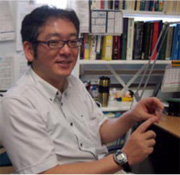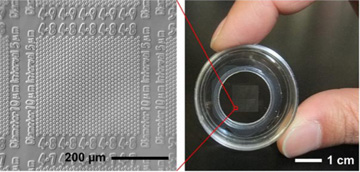Home > Highlighting JAPAN > Highlighting Japan OCTOBER 2012 > Quick Tests for MDRP and Drug Efflux Activity of Bacteria
Highlighting JAPAN
[SERIES] SCIENCE & TECHNOLOGY
Quick Tests for MDRP and
Drug Efflux Activity of Bacteria
Resistant bacteria, which antibiotics cannot destroy, have posed a problem in the medical arena in many countries. A joint research team from the University of Tokyo and Osaka University has developed a method utilizing microfabrication technologies to detect multidrug-resistant bacteria in a very short period of time. Masaki Yamada interviewed the leading member of the research team, Dr. Ryota Iino, a lecturer at the Graduate School of the University of Tokyo.

Dr. Ryota Iino holding a microfluidic device
"Healthy people do not immediately become ill, even if they are infected by multidrug-resistant bacteria," says Dr. Ryota Iino, a lecturer at the Graduate School of Engineering of the University of Tokyo. "But patients with reduced immunity who have cancer or other diseases are more prone to infectious diseases caused by multidrug-resistant bacteria. And many have died because once they are infected no antibiotic drugs can treat them."
To prevent the spread of infectious diseases caused by multidrug-resistant bacteria, the blood of hospitalized patients first needs to be examined to identify the types of bacteria, and appropriate measures must be implemented, including segregation of patients and administration of drugs. These are life and death matters so no time should be wasted in their implementation. To identify the bacteria, a detection method has conventionally been used in which bacteria are cultured and multiplied on an agar medium and identifying the types of bacteria. The major setback with the conventional method is that up to 18 hours are needed to identify bacteria. The research team led by Dr. Iino, however, last year announced a trial product for a kit that detects multidrug-resistant Pseudomonas aeruginosa (MDRP) in two to three hours. MDRP is resistant to three types of antibiotics and has been a major cause of death from in-hospital infection both in Japan and abroad. The key for the detection technology is a device called a microfluidic device, which was created using microfabrication technologies.
"The microfluidic device we developed enables accurate detection of MDRP in a short period of time by culturing the bacteria in a very narrow area measured in the order of micrometers," Dr. Iino says. "The market scale of kits for promptly detecting MDRP and other multidrug-resistant bacteria is believed to be at least 29 billion yen in Japan alone. We have now moved forward with research and development for applying the technology to other multidrug-resistant bacteria and for volume production of the kit."

A single-cell drug efflux assay device
Drug Efflux Activity
Dr. Iino's team has also achieved significant results regarding prompt detection of drug efflux activity of bacteria, which is among the factors behind bacteria acquiring multidrug resistance. The drug efflux activity of bacteria refers to a phenomenon in which bacteria discharge drugs from their cells.
Until now, it took up to 15 hours to culture the bacteria on an agar medium in order to judge whether they possess drug efflux activity. The team's method allows judgment to be made in just 15 minutes. The method employs microfabrication technology, which uses a single-cell drug efflux assay device consisting of a plate with a line of numerous microscopic holes measuring 10 micrometers ("micro" is one one-millionth). When a solution containing many bacteria is poured onto the plate, the individual bacterial cells are segregated into the holes. A compound that is decomposed when carried into a cell and emits a fluorescent color is simultaneously added. Bacteria without drug efflux activity will then start to emit light in about 15 minutes, but bacteria with efflux activity, or multidrug resistance, do not. The device makes it possible to detect bacteria with drug efflux activity more precisely because the device can check individual bacteria.
"Using the method recovers a single cell of bacteria to enable not only judgment on whether the bacteria possess drug efflux activity, but also analysis of genes that cause the activity. Analyzing the genes makes it possible to develop treatment drugs for infectious diseases caused by multidrug-resistant bacteria," Dr. Iino says. Though similar studies are also underway in the West, no method has been established that enables such quick detection of bacteria's drug efflux activity.
In September 2012, the research team applied for international patents for the method, and it plans to further improve it to enable practical application, aiming at putting it into practice at medical institutions within a few years for preventing in-hospital infections and treating diseases.
© 2009 Cabinet Office, Government of Japan






